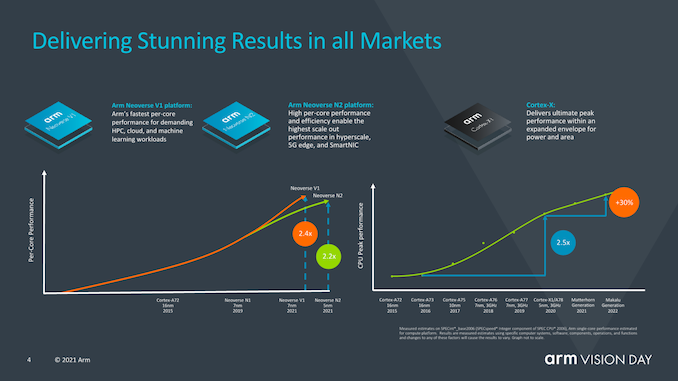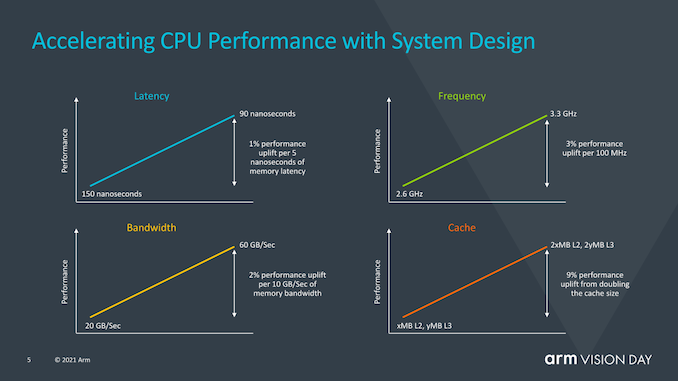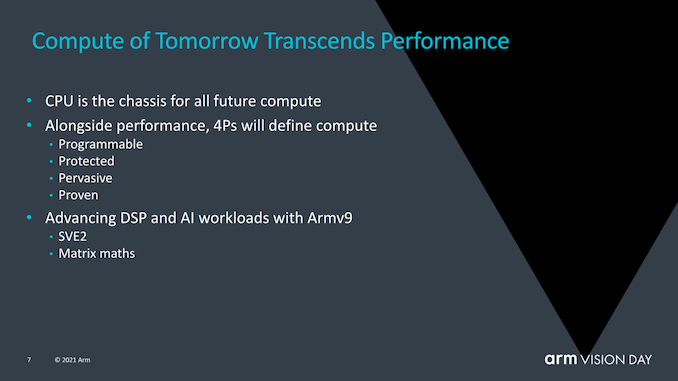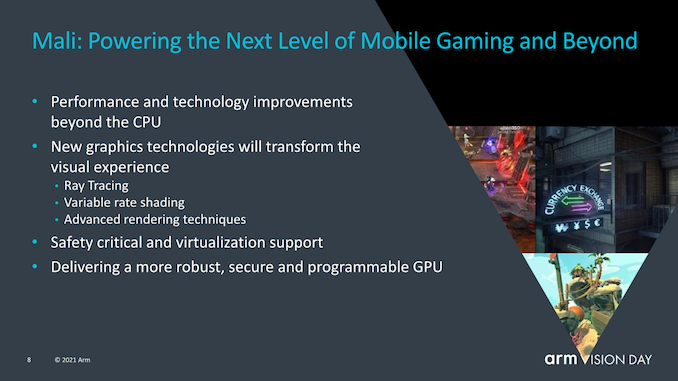Arm Announces Armv9 Architecture: SVE2, Security, and the Next Decade
by Andrei Frumusanu on March 30, 2021 2:00 PM ESTFuture Arm CPU Roadmaps
Not directly related to v9, however tied into the technology roadmap of the upcoming v9 designs in the near future, Arm also talked about some points regarding their projected performance of v9 designs in the next 2 years.
Arm talked about how the mobile space had seen performance increases of 2.4x (we’re talking purely ISO-process design IPC here) of this year’s X1 devices compared to the Cortex-A73 a few years ago in 2016.
Interestingly, Arm also talked about Neoverse V1 designs and how they’re achieving 2.4x the performance of A72 class designs, and discloses that they are expecting the first V1 devices to he released later this year.
For the next-generation mobile IP cores, code-named Matterhorn and Makalu, the company is disclosing an aggregate expected 30% IPC gain across these two generations, excluding frequency or any other additional performance gains which could be reached by SoC designers. This actually represents a 14% generational increases across these two new designs, and as showcased in the performance curve in the slide, would indicate that improvements are slowing down relative to what Arm had managed over the past few years since the A76. Still, the company states that the rate of advancement is still well beyond the industry average – admittedly that is being dragged down by some players.
Oddly enough, Arm also included a slide that wanted to focus on the system-side impact on performance, rather than just CPU IP performance. Some of the figures presented here, such as 1% of performance per 5ns of memory latency have been figures that we had talked about extensively for a few generations now, but Arm here also points out that there’s a whole generation of CPU performance that can be squeezed out if one focuses on improving various other aspects of an implementations by improving the memory path, increasing caches, or optimising frequency capabilities. I consider this to be a veiled shot at the current conservative approaches from SoC vendors which are not fully utilising the expected performance headroom of X1 cores, and subsequently also not reaching the expected performance projections of the new core.
Arm continues to see the CPU as the most versatile compute block for the future. While dedicated accelerators or GPUs will have their place, they have a hard time to address important points such as programmability, protection, pervasiveness (essentially ability to run them on any device), and proven abilities to work correctly. Currently, the compute ecosystem is extremely fragmented in how things are run, not only differing between device types, but also differing between device vendors and operating systems.
SVE2 and Matrix multiplication can vastly simplify the software ecosystem, and allow compute workloads to take a step forward with a more unified approach that will be able to run on any device in the future.
Lastly, Arm had a nugget of new information on the future of Mali GPUs, disclosing that the company is working on new technologies such as VRS and in particular Ray Tracing. The latter point is quite surprising to hear, and signals that the desktop and console ecosystem push by AMD’s and Nvidia’s introduction of RT is also expected to push the mobile GPU ecosystem towards RT.
Armv9 designs to be unveiled soon, devices in early 2022
Today’s announcement came in an extremely high-level format, and we expect Arm to talk more about the various details of Armv9 and new features such as CCA in the company’s usual yearly tech disclosures in the coming months.
In general, Armv9 appears to be a mix between a more fundamental ISA shift, which SVE2 can be seen as, and a general re-baselining for the software ecosystem to aggregate the last decade of v8 extensions, and build the foundation for the next decade of the Arm architecture.
Arm had already talked about the Neoverse V1 and N2 late last year, and I do expect the N2 at least to be eventually unveiled as a v9 design. Arm further discloses to expect more Armv9 CPU designs, likely the mobile-side Cortex-A78 and X1 successors, to be unveiled this year, with the new CPUs likely to have already been taped-in by the usual SoC vendors, and expected to be seen in commercial devices in early 2022.














74 Comments
View All Comments
melgross - Saturday, April 10, 2021 - link
Yes, before ARM had even announced their 64 bit core was suitable for anything that the servers is was aimed at, Apple came out with their 2 core version in the A7, shocking the entire industry.I would be surprised if that use this in their A15 later this year.
ballsystemlord - Tuesday, March 30, 2021 - link
They want to include ray-tracing?! Mobile phones, the biggest market I'm aware of for ARM GPUs, are not even able to afford to include the complete GPU+CPU+caches. They use too much area and power to work in that form factor.How on earth would they get ray-tracing in there too?
grant3 - Wednesday, March 31, 2021 - link
My layman's understanding of the ARM ecosystem is they're not exclusively for use in mobile phones. And that licensees can design different processors, with different tradeoffs, to suit different purposes.So perhaps it's unlikely that someone will design an ARM chip with raytracing silicon for mobile phones any time soon.
but it certainly seems plausible that sometime in the next 5-10 years, someone shall be interested in building a different kind of device with a -larger- form factor that has the thermal and power consumption envelope support a ray-tracing enabled ARM processor.
ballsystemlord - Wednesday, March 31, 2021 - link
Good point. They could be just future proofing themselves and allocating some IP so that they can compete.iphonebestgamephone - Thursday, April 1, 2021 - link
Huawei had worked on raytracing on android, shown in some demos.https://www.reddit.com/r/Android/comments/eczftf/n...
Its not like raytracing means it looks like whats shown using an rtx3080.
dicobalt - Wednesday, March 31, 2021 - link
So long as the operating system running on the ARM chip is capable of updating itself. No ridiculous Android philosophy of placing this task in the hands of inept OEMs. We're gonna need a real OS like Windows, Linux, or even MacOS.Findecanor - Friday, April 2, 2021 - link
Don't attribute to ineptitude what can be adequately explained by malice. The OEMs want you to buy new hardware when your banking app no longer works.Silver5urfer - Wednesday, March 31, 2021 - link
Ah the good old x86 death threat comments, how long it has been since the last ? Anyways AI is not going to dethrone x86, everyone is going to buy the leader's chips - Nvidia or they will make their own, also Intel has FPGA and Xilinx has FPGA as well, a.k.a AMD. So they can build specialized cores whenever they feel it.Apple is not competing in the server space, so they cannot touch AMD and Intel volumes in x86, all they do is Consumer business, all their servers also run on x86 lmao. The ARM dominance over x86 doesn't exist, as per the Servermarketshare it doesn't come close, since over 95% it is x86, and AMD is now slowly taking away Intel's share of Xeon with EPYC series.
So far no ARM processor beat EPYC Rome, next the AWS Graviton2 is excl. to Amazon, Microshaft rumors on building own chip will be exclusive, they want centralization of the power into their ecosystem because oil's age of power is over. Anyways, so what's left ? Google ? hah the incompetent and politically radicalist nature of them is utter stupid and their castration of Android is unforgettable. They are simply moving all AOSP into Google services turning it into another Apple walled garden, and their HW is pathetic, only agenda is dumbing down. So ARM works there because the phones can only run on ARM HW. Yes they outnumber desktop parts by a huge still the world relies on x86 computing, even if the SW is dumbed down (Win10 UWP etc.. Mac OS into phone hybrid OS, less power user features) there's massive market of Dell / HP / Lenovo / Supermicro / Gigabyte who all cater to x86 ONLY. So the hero ARM doesn't have an OEM lol, That latest 80C Altra Ampere ofc is available but it's weak vs AMD. Intel IceLake Xeon is coming as well, and fat stacks already went to the CTOs to get Intel HW only, Marvell Thunder ? Last time I heard they were going to build custom chips, Fujitsu A64FX ? custom. Oh I forgot, Nuvia, Qualcomm swallowed them so they are going to resurrect Centriq ? after how they axed all custom in house designs with it and pushing only ARM cores on Android.. I guess so.
Finally what does ARM provide ? more custom bs where you cannot do anything since the OEM owns your HW top to bottom and cannot have good backwards compat because the SW is made for dumbed down users ? hint - Surface SQ2, to be honest even x86 Surface has highly locked down HW. Macboooks ? everything soldered down and locked down, what else consumers have to rave so hard about ARM, i suppose Raspberry Pi which is going to dethrone x86 (Pi is amazing HW not doubting at all but people have to realize what is it that ARM is providing to them over x86 in both HW and SW stack and user customization) Finally the Switch, it is huge in numbers and a new HW is on the horizon for the DLSS equipped HW Pro edition but is it comparable to the AMD SoC in Xbox and PS ? nope.
But yeah x86 is going to die lmao.
viktorcode - Wednesday, March 31, 2021 - link
I would love to archive this comment for posterity...Wilco1 - Wednesday, March 31, 2021 - link
"So far no ARM processor beat EPYC Rome, next the AWS Graviton2 is excl. to Amazon"If you had bothered to read the Milan review, you would know that Ampere Altra not only outperforms Rome by a good margin, but matches Milan as well (1% faster on 1S SPECINT_rate). All that with a 2-year old core and 1/8th of the cache... ~15% of AWS is now Graviton and still growing fast, so it is obviously displacing a huge amount of x86 servers.